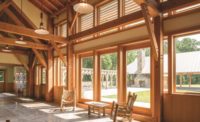Designed by renowned Finnish American architect Eero Saarinen and built in 1960, Hill College House at the University of Pennsylvania in Philadelphia, Pennsylvania, underwent a 15-month, $80 million, LEED Gold certified renovation. The internationally recognized landmark reopened to 500 student residents in August 2017. One of 12 undergraduate houses at the university, Hill College House combines residential, academic, and social programming under one roof, an integral part of Penn’s “College House” system.
The five-story, 195,000-square-foot brick residence underwent a comprehensive renovation, preserving Saarinen’s revolutionary design vision for communal living with numerous public spaces at varying physical and social scales. The first purpose-built women’s residence at Penn, Hill College House features an allegorical entry bridge over a landscaped moat with a protective spiked metal fence. Student lounges and seminar rooms surround a vast central atrium that overlooks a dining area on the lower level.
Saaarinen’s Vision
Saarinen grounded his design concept in the idea of a village: self-sufficient, inward-focused, and protected. The interior of Hill College House offers more public and communal space than any other residence hall on campus. The village metaphor carries through the building interior. A plan centralized around a large atrium (the grandest public space in the building) is ringed by four “villas,” each of which is accessed by a floating staircase. The atrium is open to all floors, with a range of important vertical and horizontal vistas.
The student rooms at Hill College House historically played a secondary role to the public spaces. While Saarinen included some variety in the room layouts, there is general uniformity to the spaces, which were (and remain) small. The renovation design team made a conscious decision to preserve the small residential room sizing, sharing Saarinen’s view that the communal areas would invite the gathering and relationship-building so integral to the college experience.
Significant and Approach
Hill College House is designated Distinguished I, Penn’s highest category in its rankings of significance for campus buildings. No major renovation had been performed at Hill College House since it was built. Although the architecture continued to foster a strong sense of community, the dated systems, worn finishes, and lack of air-conditioning combined to make the building unappealing to prospective residents.
Mills + Schnoering Architects, LLC, of Princeton, N.J., led an extensive renovation design team. The firm has particular interest in the restoration, renovation, and adaptive reuse of midcentury modern buildings and sites.
“Our approach respects the original Saarinen Hill College House design, preserving its legacy,” said Mills + Schnoering Partner-in-Charge, Michael J. Mills, FAIA. “Our choices were inspired both by the integrity of the architecture and the contemporary student experience, with a design meant to balance the two in a welcoming, accessible student residence.”
The Main Goals
Penn wanted to bring the residence to contemporary standards while retaining its character. Goals included strengthening communal living at the heart of Hill’s design; respecting historic materials and details; creating comfortable, welcoming, and accessible student accommodations; and attaining LEED Silver certification or higher. Architecture and interior design together ensured consistency of aesthetics, functionality, and design intent. To respect the building and its details, much of the plan was retained. In some cases, dated program areas—ironing alcoves, telephone booths—were removed to capture space for modern needs.
Renovation choices collectively refreshed building elements and the integrity of Saarinen’s design:
- Expansion of dining facilities by 50 percent, with major kitchen upgrades, to serve Hill College House and other campus dining venues.
- Reconstruction of the iconic entry bridge and landscaped moat.
- All new MEP systems and the introduction of air-conditioning.
- Conversion of bathrooms to all-gender multi-stall restrooms and shower rooms, the first in a Penn residence.
- Installation of LED lighting in the atrium.
- New elevator and lifts for full accessibility.
- New furniture and finishes chosen to echo the building’s midcentury style and reinterpret Saarinen’s bold color palette and furnishings.
- Interior glazing between corridor lounges and hallways to bring natural light farther into the building.
Building Envelope Challenges
With sustainability at the heart of the renovation, the team focused on opportunities to update and enhance the building envelope, guided by envelope consultant Edwards & Company of Sellersville, Pa. Examining existing conditions and identifying improvements—without markedly changing the historic fabric—were critical to achieving energy efficiency upgrades. Ninety-five percent of existing walls, floors, and roofs were retained.
New reflective roofing reduced the building’s heat island effect. Existing EPDM synthetic rubber roofing on 2-inch rigid foam insulation was replaced and augmented with new fleece-reinforced EPDM with improved durability and reflectivity. A minimum 4-inch layer of polyisocyanurate insulation (also referred to as PIR, polyiso or ISO) was added beneath the new roofing for improved energy conservation.
The original perimeter walls lacked insulation. The small size of the student rooms—and desire not to make them smaller—presented a challenge to adding perimeter wall insulation. Thin Atlas Wall Board Energy Shield Pro 2 insulation was selected for its very high thermal properties. Dimensionally, the new layer of insulation occupied the space of the former baseboard radiators, so that space within the rooms was not compromised. Radiators were replaced during the renovation with a new ceiling-mounted valance heating and cooling system, providing air-conditioning and individual student climate controls while preserving floor and wall space.
Glazing Updates
All 400+ original steel windows were rehabilitated to improve thermal and acoustical performance. Glaziers from Window Repairs & Restoration LLC, of Gloucester City, N.J., removed each window frame from its opening, sandblasted, repainted, and reset it into position before replacing the original single-pane glazing with quarter-inch laminated glass. New hardware to replicate the original was remade to match and then retrofit to each window.
The atrium curtain wall was similarly updated. The existing curtain wall incorporated one-quarter-inch single-pane glass attached to a steel skeleton of vertical I-beams with a “zipper wall” gasketed glazing system. To preserve the original steel fins, glaziers from National Glass & Metal Company Inc. of Horsham, Pa., conceived and executed a modification to a typical structural glazed cassette system. The technique used structural tape to affix new laminated glass to cassette frames with modified details to work in the historic steel. Interior aluminum trim details simulate the original gasket system for a near-perfect match. The result incorporates new glass for improved energy performance with virtually no change to the original aesthetic or sight lines.
A significant portion of the historic handcrafted Eno brick façade was repointed with new mortar to match original conditions, including complete repointing of the brick walls at the fence around the moat. The brick flares at the bottom corners of the building, each of which engages with the landscape, had been lost and were reconstructed during the project to re-establish the historic relationship of the building to its landscape. The masonry craftspeople of Dan Lepore & Sons prepared samples for the architect’s and Penn’s approval as to color, texture, and tooling. The mortar was based on the color, texture, and strength of the original mortar, as analyzed several years earlier by conservator Chris Frey of Keystone Conservation, and confirmed again during this project.
The basic black color had faded to gray. Because the walls were not 100 percent repointed, the new mortar was made to match the patina of the original mortar that remained in place. The tooling was very carefully done by hand to match the original, which was not struck far back from the face of the brick. All of the work was done to consistently high standards for an indistinguishable match.
Per university requirements, the renovations were designed and programmed to the standards of LEED Silver. In January 2018, the team was informed that the project had, in fact, achieved LEED Gold certification. The project earned points for optimizing energy performance, enhanced commissioning, and building reuse.
A Collaborative Team
As with any comprehensive historic renovation, the design team and Penn had to strike a balance between old and new. Teammates worked collaboratively and addressed problems early to avoid delays during construction. The preservation approach involved conservation, original materials analyses, and archival research to understand both Saarinen’s original documented details and appropriate contemporary replacements or complements. The renovation demonstrates how sophisticated new systems and amenities can be woven into historic architecture. It also attests to the team’s collaborative skills and design sensitivity, which allowed the interventions to fit seamlessly into the original architecture.













